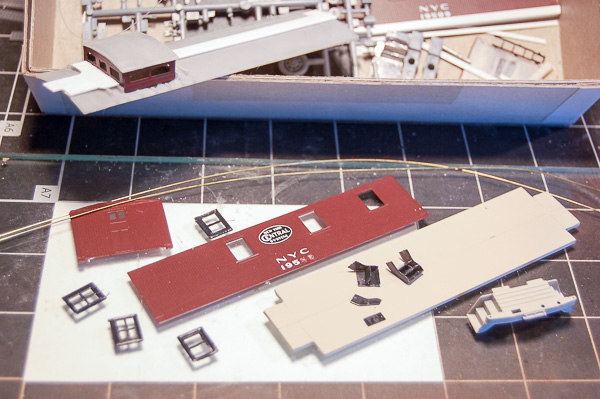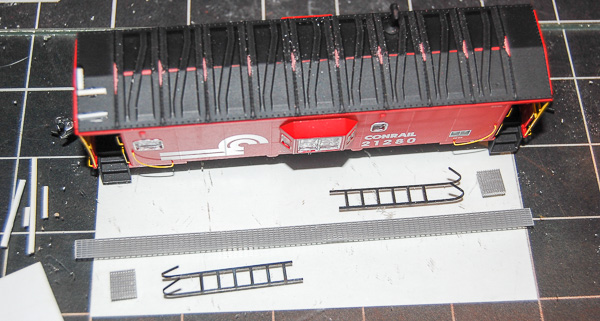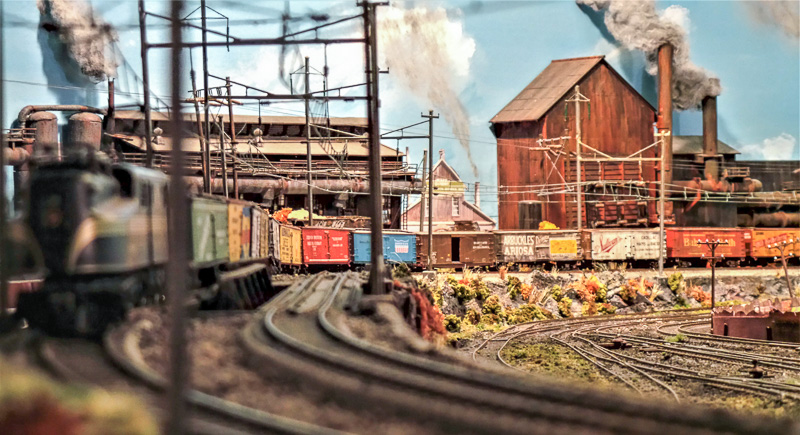
by Ron Polimeni
When my friend Don Florwick first initiated TT/TO operations on his NYCS Pittsburgh & South Pennsylvania Railroad (P&SP), he needed cabooses. Models of NYCS’s 19000 series cabooses were the obvious choice. To that end, Don purchased 16 of the kits offered by Waterlevel Models for these cabooses. As building the Waterlevel kits would take time, in the interim, Don also purchased a pair of 19000 series NYC cabooses from Trix as well as a small fleet of bay window cabooses from Walthers.
The Walthers stand-in’s unfortunately were lettered for Conrail and consequently were bereft of end ladders and roof walks. They performed well, but the sight of a modern Conrail caboose bringing up the rear of a 1950’s era NYC consist had the effect of finger nails on a black board every time one passed me by during an operating session.
Learning of Don’s stash of Waterlevel kits, I offered to build them for him as he had enough on his plate maintaining a rather large layout to operational standards (which he does very well). I began by taking a single kit to examine with the intent of determining the best approach to gang building the fleet. I found however, that these kits were probably never intended as fleet equipment for operating sessions.
The Waterlevel NYC cabooses are high quality plastic craftsman style kits. The model company did their homework and the instructions are well written as well as informative, providing much background information on the NYC 19000 series wood cabooses. The kits themselves however, are a bear to assemble. As the picture (below) shows, the steps are constructed out of six tiny pieces that are nearly impossible to hold in proper relation to each other while applying glue. For sixteen cabooses this would require constructing a total of 64 step assemblies.
Since what Don needs are operational pieces, not contest pieces, we began looking for options. In the right hand corner of the pic is a set of steps from an Athearn “blue box” caboose kit. These steps, complete with end platform are a nearly perfect substitute for the steps in the kit. With the help of Jay Beckham we will be looking into having them 3D printed. The Waterlevel kits are therefore on hold for the time being.
As yard master for Somerset yard, switching the bay window Conrail cabooses when making or breaking up a coal extra was especially grating. To that end I offered to back date the cabooses. Don is in the process of realigning a section of mainline with the consequence of having to cancel Novembers operating session. This has allowed time to repaint and back date the Walthers bay window cabooses.

The prototype for these Walthers bay window cabooses is most similar to Conrail as class N21. They are very nearly correct for NYC’s Lot 782, built in 1949 by Despatch Shops Incorporated. They have the correct bay window but the other windows should be square double pane rather than have the rounded corners with riveted aluminum trim. In the interest of simplicity and the need to have them back in service within a limited time period, Don elected to invoke modelers license and say the cabooses were purchased directly by the P&SP due to a shortage of NYC hacks.

To that end, all I have to do is backdate them to a 1950’s appearance. Tichy Train Group came to the rescue with roof walks and friction bearing caboose trucks. Tichy has to be one of the best deals on the market for model railroaders. Their products are of the highest quality with some of the finest castings I’ve ever had the pleasure of working. Plus their prices can’t be beat. A box of 10 trucks goes for 15.50 albeit with plastic wheels. The wheels however, are of the correct tread profile. The roof walks come three to a package for 5.95.
The Walthers cabooses came with very nice metal wheels. As can be seen in the photo, the wheels have been exchanged on the trucks with the metal wheels being installed in the Tichy frames and the Tichy wheels being placed in the roller bearing frames ( the pile in front of the cabooses). The third pic shows the roof of one of the cabooses with the file marks where the ribs have been filed down to accommodate the metal roof walk. Supports will be added at the ends of the roof with bits of styrene bent to shape and filed flat. The ladder walks are supported the same way with bits of styrene cut to shape. The ladders are gleanings from the scrap drawer where fortunately, I had just enough for the six cabooses. However, scale ladder stock is available from several sources.
Once the roof details are completed the cars will be painted the standard NYC box car red with black roof. To avoid having to disassemble the car bodies, I decided to use Micro-Mark liquid masking film to cover the windows. This is a rubber like film that can be peeled off. Tedious to apply but much easier than disassembling a half dozen models that weren’t designed to be disassembled.
The cabooses should be back in service in time for Don’s December operating session. All he has to worry about now is having the mainline to Wheeling back in service by then.
As for the Waterline models, that’s another story for another time. Perhaps by the next installment of the Wheel Report I’ll managed to have the steps and end sills recreated via 3D printing and will be able to convey how I fared with that adventure.

